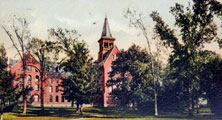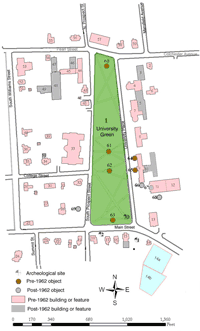 |
University Green Area Heritage StudyHistoric Burlington Research Project - HP 206Historic Preservation Program - University of Vermont |
Dewey Hall
Dewey Hall, located at 2 Colchester Avenue, is at the head of
Pearl Street where it intersects with North and South Prospect Street. Its
three stories are constructed of gray terra cotta and red brick.
[1]
The building was constructed in
Some of the earliest classes taught
at the Medical College were in 1809, thus making the University of Vermont’s Medical
Department one of the oldest in the United States.
[3]
The University’s first Medical College, now known as Pomeroy Hall, located on
Main Street opposite the south end of the University Green, was built in 1829.
[4]
However, it closed in 1836 due to a lack of students, and was used by the chemistry
department until the Medical Department was
reorganized in 1854.
[5]
The Medical Department was allowed to
reoccupy the building as long as they kept it maintained.
[6]
In 1858, renovations were done in order to maintain the Medical College. However,
by 1875, the building was once again in need of repair.
April 8, 1904, four
months after the fire, the trustees instructed that preliminary plans for a new
building be drawn up; a fund-raising campaign
was started later that month. The construction of a new building that would be “completely
The
building was designed in the Neoclassical style by Burlington native Walter Ross
Baumes Willcox (1869-1947). Willcox was one of the only professionally trained
architects in Burlington at the time; he trained at the University of
Pennsylvania in addition to a year of advance study in Europe. Willcox was highly
influenced by the Jacobethan style; his designs in this style can be seen today
at
59 North Prospect St., 266 South Union
St., 148 College St., and at 255 South Willard St. Willcox was also interested
in other styles such as the Beaux-Arts style, which can be seen on College
Street in the Carnegie Library, as well as the Colonial Revival style. Willcox found
success in Burlington, yet it was his goal to belong to a larger and more
progressive community; he believed that “…architecture, along with other arts,
is an expression of the values, aspirations and character of the society that
produces it.”
[12]
Thus, he
only practiced in Burlington from 1895 to 1907, when he moved to Seattle. There
he formed a partnership with William J. Sayward, a young architect from
Woodstock VT., and engaged in city planning, municipal affairs, and became an
active member of the American Institute of Architects.
[13]
Willcox remained in Seattle until 1922, when he moved to Eugene, Oregon where he
remained there for the next twenty years, devoting himself to teaching and
becoming the head of the State School of Architecture; where he created an
architecture program which not only became a prototype but led to a reformation
in the training of future American architects.
[14]
When
built, the new building was fireproofed and contained three floors consisting
of a basement, first floor, second floor, and third floor; it also contained a
ventilating system. It was heated by steam and lighted by gas and electricity.
[15]
The basement contained a coat room, a boiler room, coal storage, a fresh air
chamber, a lounging room, toilet room, storage, a reception room surrounded by
three consultation rooms, and a room for ashes. The first floor contained a
histological and pathological laboratory, a library, a bacteriological
laboratory, an obstetrics room, a patient’s room, a coat room, a lecture hall,
an ante room, a business office, toilet, faculty room, and
four storage rooms. The second floor contained a chemical laboratory, a
pharmacology room, three recitation rooms, private chemical laboratory, two
lecture rooms, minor surgery and bandage room, the upper part of the main
lecture hall, and an experiment room. Finally, the third floor contained a
museum, physiology room, curator’s office, dissecting room, prosecting room,
demonstration amphitheater, locker room, a recitation room, lecture room, three
storerooms, and three open classrooms.
[16]
As early
as 1914, the Medical College was once again in danger of closing due to the
recommendation of the Carnegie Institute. Yet, this recommendation never came
to fruition thanks to the intervention of the University and the legislature. In
1919, the office of the President of the University, as well as the offices of
his administration, joined the Medical College. The Medical College expanded
its student body in 1921, when it began to accept women into the program.
[17]
In 1924, the Medical College had large laboratories for chemistry, anatomy,
physiology, histology, bacteriology, physiology, clinical microscopy,
embryology, and pharmacology, as well as rooms for “practical work,” recitation
rooms, lecture halls, Anatomical and Pathological Museums and the University
library. Additionally, the first floor contained the offices of the comptroller
and registrar as well as the President of the University. On the second floor
were the offices of the Vermont Children’s Aid Society, while the third floor contained
the offices of the editor of University Publications, Alumni Council, Alumni
Secretary, and Alumni Weekly.
[18]
In 1969,
the Medical College underwent renovations in order to become the home of the
Psychology Department.
[19]
The laboratories,
dissecting rooms, lecture rooms, library, lounge room, museum, as well as the
corridors were all renovated. The rooms were divided into smaller spaces and
turned into offices, which created space for more offices to be placed in the
middle of the corridor. In the basement, what used to be the student lounge is
now the Behavioral Therapy Center; the rest has been converted into office
space. The lecture hall on the second and third floor is all that remain of
Willcox’s original design. The fourth floor, like the other floors, was
renovated into office space, and is currently a restricted area where research
takes place.
[20]
On
November 10, 1969, the Medical College was dedicated to John Dewey, who was a
philosopher educator, and “…world famous for his teaching and writings on
education and philosophy.”
[21]
The Medical
College is now referred to as Dewey Hall, and is still the home of the
Psychology Department.
Text and photo by Robyn Sedgwick, 2011
Fig. 1-3, Martin Kauffman, University of Vermont College of Medicine (New Hampshire:
University of Vermont College of Medicine, 1979), 24, 88, 95.
[1] “University Buildings: The Medical College,” The Vermont Alumni Weekly, December 3, 1924. [2] Ibid. [3] “Department of Medicine,” University of Vermont and State Agricultural College Catalogue 1904-1905, 139. [4] Martin Kauffman, University of Vermont College of Medicine (New Hampshire: University of Vermont College of Medicine, 1979), 24, 86.
[5]
Martin
Kauffman, University of Vermont College
of Medicine, 53.
[6] Ibid, 53. Ibid, 86. [7] Martin Kauffman, University of Vermont College of Medicine, 86-89. [8] Ibid, 94. [9] Ibid, 94-96. [10] “Building Contract,” (Campus Planning Service files, University of Vermont). [11] Ibid, 96-100. [12] Clark Schoettle, “Deceased architects and builders who have worked in Burlington VT,” 20. “The Department of Architecture: History,” architecture.uoregon.edu/about/history. [13] Clark Schoettle, “Deceased architects and builders who have worked in Burlington VT,” 20. Alan Michelson, Pacific Coast Architecture Database: Walter Willcox, https://digital.lib.washington.edu/architect/architects/2370/. [14] Clark Schoettle, “Deceased architects and builders who have worked in Burlington VT,” 20. The Department of Architecture: History, architecture.uoregon.edu/about/history [15] Department of Medicine, University of Vermont and State Agricultural College Catalogue 1904-1905, 139. [16] Campus Planning drawer 14 “1904 drawing plans”, 35-37. [17] National Register of Historic Places Continuation Sheet Section number 7, http://www.uvm.edu/histpres/HPJ/NR/uvmgreen/dewey.html. [18] The Vermont Alumni Weekly “University Buildings: The Medical College” Vol. IV, No. 9, December 3, 1924. [19] “UVM President Rowell Dedicates Dewey Hall for Psychology Studies,” The Burlington Free Press, September 11, 1969. [20] Walter L. Hough, First Floor Plan Second Floor Plan, 1968, (Campus Planning Services files, University of Vermont). [21] “UVM Dedicated Dewey Building Today,” The Burlington Free Press, 10 September 1969. |




